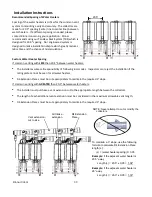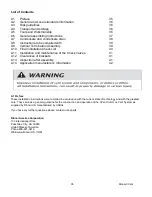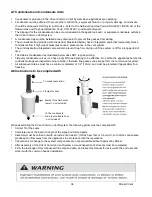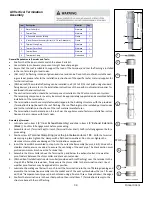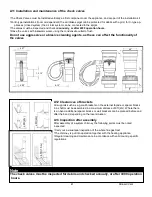
36
Rinnai CVent
A2 General and Local standards information
When installing and operating the CVent Common Vent System, the following valid standards and regulations must be
complied with and adhered to:
•
Local codes or, in the absence of local codes, with the
National Fuel Gas Code, ANSI Z223.1/NFPA 54
, or
the
Natural Gas and Propane Installation Code, CSA B149.1
.
•
Appliance Manufacturers Installation Instructions
•
Regulations on supervision of construction
•
Statutory provisions
•
Work must only be carried out by a licensed professional.
Fill out spec table at the back of this manual and keep this manual with the system after completion of the in-
stallation.
A3 Risk guidelines
•
All components of the CVent Common Vent System are produced and built in accordance with valid stand-
ards, regulations and safety engineering rules.
•
Risks to life and limb of the user or of the third party or impairments or damages to property can arise in the
case of improper assembly or handling.
•
To avoid such risks, the CVent Common Vent System must be installed and used only for the designated
intent as described in this manual.
•
Deficiencies or damage of the CVent Common Vent System must be addressed and repaired immediately.
•
For roof or chimneys modifications, we refer you to the valid industrial safety regulations.
•
These must especially be complied with, unconditionally and at any time, when working on roofs and fa-
çades.
A4 Transport and storage
When transporting CVent Common Vent System components the following points must be complied with:
•
Transport CVent Common Vent System components in a clean dry environment and only in its original
packaging.
•
If stored or transported at temperatures below 32 F (0°C), the CVent Common Vent System components
must be warmed up to 60F (15°C), before the start of assembly.
•
Components must be protected from solar emission. The CVent Common Vent System components must
be stored in a non UV-charged environment.(i.e. do not store outdoors!)
•
The CVent Common Vent System components must be stored in original packaging.
A5 Tools and workmanship
Standard trade tools are sufficient for cutting and assembly of the CVent Common Vent System components.
Following is a list of tools or equipment that may be necessary:
Workmanship shall include the following:
•
When cutting vent components, the cut must be straight. Cut edge shall be chamfered and all burrs re-
moved before installation.
•
All vent joints shall fully engage the male / female socket assembly
•
Installed vent system shall be clean and free of any foreign debris before operation.
•
Vent system shall be rigidly supported as instructed in this manual and include the appropriate 3° slope.
•
Gloves
•
Fine Tooth Saw
•
Weather Proof Sealant
•
Safety Glasses
•
Screw Driver
•
File or Sandpaper
Summary of Contents for c199i
Page 43: ...43 Rinnai CVent NOTES ...
Page 86: ...86 CVent de Rinnai NOTES ...
Page 87: ...87 CVent de Rinnai NOTES ...









